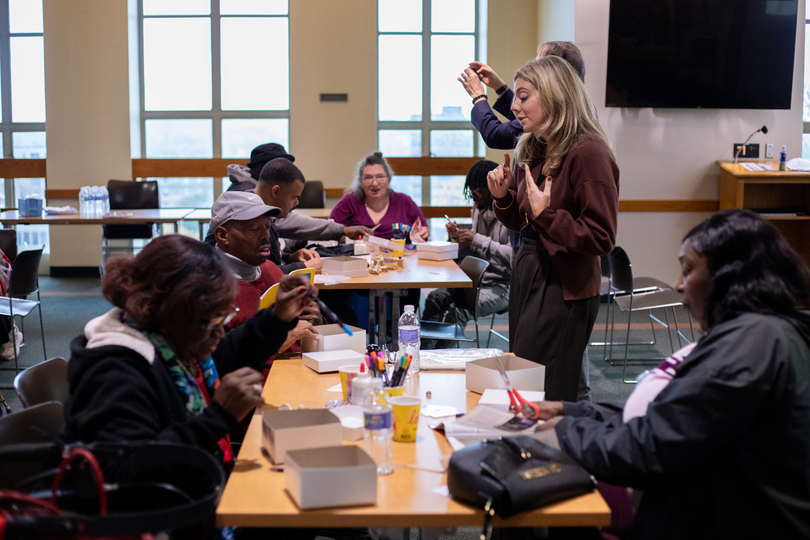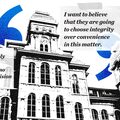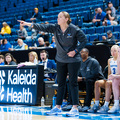Artistic Noise helps at-risk youth express themselves through art

Artistic Noise, a Harlem-based nonprofit started 25 years ago, helps at-risk youth create art. Artistic Noise staff and alumni reflected on their work at a central New York incarceration working group event at SU Monday. Leonardo Eirman | Photo Editor
Get the latest Syracuse news delivered right to your inbox.
Subscribe to our newsletter here.
Artistic Noise, a Harlem-based nonprofit, started when two women, Francine Sherman and Lauren Adelman, initiated an art-making activity for a juvenile detention center for girls in Boston.
After one girl was released, she joined Awais and Adelman in forming the program dedicated to assisting youth aged 14 to 22 who face challenges in foster care, shelters, probation and mental health issues.
Now, 25 years later, current Artistic Noise staff members and alumni reflected on their work at a Monday event. The Incarceration and Decarceration Working Group of the CNY Humanities Corridor hosted it at Syracuse University’s Hall of Languages.
Executive Director of Artistic Noise Calder Zwicky said the organization sets itself apart from other nonprofit organizations by providing economic support to high school and college students while offering them the opportunity to create art in a safe and celebratory environment.
Attendees of the event worked on a recreation of one of Artistic Noise’s recent courthouse projects, “Identity Boxes.” The craft was meant to encourage self-reflection and inspire youth impacted by the carceral system, Zwicky said.
Zwicky said many participants in Artistic Noise had never held a paintbrush before joining the program, but now showcase their artwork at annual exhibitions in New York City to share their creations with the community.
Members of Artistic Noise earn a stipend of $17.50 for each hour they spend in the studio and receive 100% of the proceeds from sales at art shows. Many of the works created in the program convey themes of self-identity, resilience and connection.
While some participants leave their exhibitions with thousands of dollars, the true gain is the personal growth developed throughout the program, Zwicky said.
“We really respect their artistry,” Zwicky said. “We make these shows as close to a museum show or art gallery as possible. We create brochures and have collectors come out; it’s a really beautiful experience, and it’s one of the high points of what we do all year.”

Leonardo Eirman | Photo Editor
Executive Director of Artistic Noise Calder Zwicky said the organization provides economic support to high school and college students while offering them the opportunity to create art in a safe and celebratory environment.
Artistic Noise collaborates with the Center for Justice Innovation’s Project Reset, where therapists and staff work with participants whose court cases are often dismissed or declined to be prosecuted. Their programs provide a fast turnover to youth in need, Zwicky said.
Manager of Artistic Noise’s Alumni Artist in Residence program Samantha Cortez joined as a participant when she was 17 years old, now she’s the program’s lead teaching artist. She’s completed her own mural and has works displayed in several New York City exhibitions, she said.
“Many young people don’t have any adults advocating for them at all, so we take that place in their lives,” Cortez said.“It’s really like this welcoming and warmth that happens, and we help them navigate and play on their strengths.”
Director of Art Therapy and Youth Services Victoria Hristoff said art therapy is used to enhance the program and removes the “hierarchy” that comes with the traditional talk therapy.
“Therapy isn’t just sitting in the office and having a session,” Hristoff said. “Sometimes it’s going for a walk, grabbing a slice of pizza, or sitting down and painting a picture.”
Artistic Noise works to ensure that any young person who has been harmed by the system has a safe space to create art and make emotional progress, Zwicky said.
“We see kids get off probation two years early; we see kids get their ankle monitor taken off six months early; just having an organization advocating for you, showing up in court for you really helps the young people,” Zwicky said.
Through their Art and Care program, the organization offers access to materials like free subway cards, food, drinks, childcare supplies and art supplies to any participants that need them.
“The system tries to keep people, especially youth, silenced and out of sight,” Zwicky said. “We refuse to be silent, we refuse to go away. We’re going to make some noise, but we’re going to do it creatively.”






